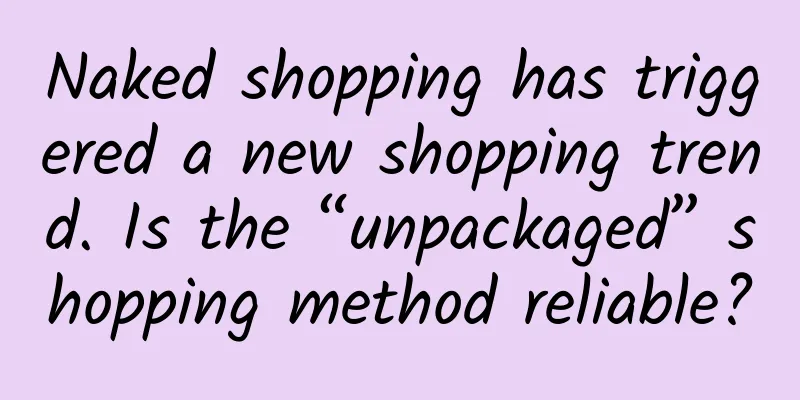Naked shopping has triggered a new shopping trend. Is the “unpackaged” shopping method reliable?

|
The piles of paper boxes, tapes, and fillers after online shopping, and the plastic bags that are thrown away after consumption, make people feel that shopping is fun for a while, but the garbage is obvious. Has the "unpackaged" life of carrying a basket to buy vegetables, bringing your own container to buy soy sauce, and using a straw to buy fish and meat gone far away from us? Or has it returned to us in a different way? Image | Unsplash In addition to "quitting without a plan", is there also "buying without a plan"? Unlike "quitting without any preparation and without a clear plan for the next step", "buying without any preparation" requires some preparation! Naked shopping means that consumers bring their own containers and buy bulk goods in unpackaged stores. Since the goods are not pre-packaged, the price is generally calculated by weight or number of pieces. Does this method seem familiar to you? Isn’t this just another way of expressing the consumption methods of free-for-all, free-for-all, bulk, and retail? Under various expressions, what remains unchanged is to remove the attraction created by exquisite packaging, eliminate the premium generated by packaging, and see the use value of the purchased product itself. This prompts us to think seriously when shopping: is it the product itself or its packaging that we are buying? Image | Unsplash When we choose to "buy naked", in addition to what to buy, we also have more decision-making opportunities on how much to buy and what packaging to use. In unpackaged stores, some products are usually in bulk, and consumers can freely choose the purchase quantity, which can be a small amount for trial or a large amount for home use. This can also reduce the idleness and waste of unsuitable and unpopular products to a certain extent. In addition, consumers can prepare containers in advance before shopping, which can be sealed bags, glass containers, previous product packaging, etc. This will also save the steps of storing and disposing of packaging waste again. Image | Unsplash In order to deal with the situation where consumers forget to bring their own containers, some stores that support naked shopping will also provide some paper bags, but encourage customers to reuse these paper bags the next time they shop. In addition, some stores will also provide reusable glass or plastic containers donated by other customers. If you have extra containers at home, you can simply wash them and bring them to the store, where they will be disinfected and used by other consumers. Figure | NOW Financial News Is this packaging a must? In addition to being a protective outer layer for products, packaging also carries an important sales responsibility. Therefore, when designing packaging for general products, the company will focus on factors such as product storage, sales environment, and cost, and design a suitable solution to effectively support marketing strategies. As a result, many businesses will spend a lot of time and effort on packaging, even leading to excessive packaging. In the fields of food and cosmetics, excessive packaging is particularly prominent. This is mainly manifested in excessive number of packaging layers, large packaging gaps, high packaging costs, and improper material selection. [1] In order to effectively manage this, the newly revised mandatory national standard "Limiting Excessive Packaging of Commodities, Requirements for Food and Cosmetics" was officially implemented on September 1 this year. Chen Hongjun, deputy director of the Standard and Technical Department of the State Administration for Market Regulation, once explained in his interpretation of the standard that research shows that packaging waste in my country accounts for about 30% to 40% of urban domestic waste, and most of this packaging waste is caused by excessive packaging. [2] In addition to wasting resources and polluting the environment, excessive packaging will also impose packaging costs on consumers, damaging their legitimate rights and interests. Therefore, the mandatory national standard "Requirements for Restricting Excessive Packaging of Goods: Food and Cosmetics" has made clear requirements on the number of packaging layers, packaging void ratio, and packaging costs. It points out that except for packaging that is in direct contact with the contents, the cost of all packaging shall not exceed 20% of the product sales price. "Naked buying" goes a step further on this basis. Through the "no packaging" form, it reduces the resource consumption in the production and transportation of various types of packaging from the source, thereby reducing the generation of a large amount of packaging waste. Domestic naked purchase map, waiting for you to complete At present, many stores in China have begun to promote "naked shopping" consumption.
Photo | Beijing Organic Farmers Market
Photo | #CareGroceryLagomZakka
Are there any stores that support "naked shopping" in the city you live in? Feel free to share your city, store name, main products sold, as well as your opinions and shopping experience in the comment section. Do packaging-free stores have a future? It is not difficult to see from these unpackaged stores that "naked shopping" is very similar to the model of traditional wet markets, both of which are bulk purchases. The only difference is that traditional wet markets provide plastic bags, while unpackaged stores do not. The products are generally mainly food ingredients and daily necessities, such as organic fruits and vegetables, grains, seasonings, oils, dried fruit snacks, cleaning products, and bath products. Some stores also have environmentally friendly small items carefully selected by the store owner, such as environmentally friendly straws, environmentally friendly toothbrushes, reusable cups, etc. Due to the "unpackaged" sales format, store owners are often more willing to focus on local products when purchasing, which facilitates communication with suppliers, hoping that suppliers can achieve environmentally friendly shipping methods within their capabilities. In addition, store owners also need to make special efforts to publicize product information in the store and store products, carefully select sealed containers, and control product quality and purchase and sales conditions. In addition, some packaging-free stores will recycle packaging and containers for consumers who do not bring their own containers, which also increases the manpower and time costs of cleaning and disinfection. At present, the domestic "naked purchase" model is in its infancy, and "package-free stores" have not yet been widely popularized. The concerns about their operation may be as follows: 1. Not all products are suitable for “unpackaged” sales, and not all suppliers are willing to ship “unpackaged”; 2. Compared to supermarkets, which usually offer multiple brands of the same product for consumers to choose from, the products in "package-free stores" are often not "selective"; 3. When consumers bring their own containers for shopping, the processes of filling, weighing, deducting weight, and calculating prices take longer than scanning the barcode on the product packaging, increasing the time cost for both buyers and sellers. However, the starting points of packaging-free stores and supermarkets are very different. Supermarkets emphasize convenience, efficiency, and provide a variety of choices to meet daily needs at one time. However, packaging-free stores pay more attention to environmental friendliness and reduce the generation of packaging waste from the source. Although some additional investment may be needed in the initial stage to increase consumer participation, in the long run, naked shopping can reduce corporate packaging costs and terminal waste disposal costs. As public environmental awareness increases and green consumption concepts become more popular, general stores offering the "naked shopping" option can also attract more environmentally friendly consumers, thereby expanding the customer base and increasing sales. In fact, the trend of “naked shopping” has spread all over the world. As early as 2014, a store called “Original Unpackaged” in Berlin, Germany, began selling unpackaged food, making it one of the pioneers in Germany. The founder, Milena Glimbovski, won the Berlin Women Entrepreneur Award for 2018/2019. [10] Today, there are more and more “unpackaged stores” in Germany. A map of packaging-free stores in Germany created by environmentalist SHIA (blue dots are packaging-free stores, and yellow dots are stores that offer additional packaging-free discounts) In South Korea, many cosmetics brands have also introduced packaging-free sales models. For example, Aromatica’s lotions, emulsions, facial cleansers and other products all allow consumers to bring empty bottles to its experience centers for weighing and purchase. [11] As more and more brands and consumers embrace "no packaging", the sustainable consumption method of "naked shopping" will be widely expanded. As consumers' demand for "naked shopping" increases, it is expected that more stores will have the option of naked shopping. More brands and companies will increase their consideration of green packaging when designing products, develop new packaging strategies and supply chain management methods, and reduce the generation of packaging from the source. Ultimately, the proportion of packaging waste in domestic garbage will also be greatly reduced. Although naked shopping may not be the ultimate solution to plastic pollution and packaging problems in the long run, it is providing us with a new idea to change our disposable consumption habits: try to reuse in personal life to reduce the waste of disposable packaging, and gradually transition to a systematic reuse model. If you are interested in "naked shopping", you can try to follow this guide to start. If you still have concerns, why? You are also welcome to tell us in the comments section! References [1] Notice of the General Office of the State Council on Further Strengthening the Management of Excessive Packaging of Commodities (Guobanfa [2022] No. 29 (2022)) Chinese Government Website. Available at: https://www.gov.cn/zhengce/content/2022-09/08/content_5708858.htm [2] Mandatory national standards for regulating food and cosmetics packaging issues (2021) China National Radio. Available at: http://food.cnr.cn/rdjx/20210903/t20210903_525589147.shtml [3] A chart to understand | "Limiting Excessive Packaging Requirements for Food and Cosmetics" (2021) State Administration for Market Regulation. Available at: https://www.samr.gov.cn/xw/tp/art/2023/art_cd4f1e0db5634c0dbac60aa3dc5cffc9.html [4] Carrie Yuyuan THE BULK HOUSE Xiaohongshu account homepage (2022). Available at: https://www.xiaohongshu.com/user/profile/571d9f4d84edcd7ba58bbf8e [5] Introduction to Beijing Organic Farmers Market (2017) WeChat public platform. Available at: https://mp.weixin.qq.com/s/aoi-HLFnTD5mR50KCsnzYw [6] Foodthink (2023) When design meets food: The rebirth of a community food store in Beijing after ten years | Food Think Vol.20, WeChat public platform. Available at: https://mp.weixin.qq.com/s/upR-oLawx_UbaFhy42d1wQ [7] Xiamen’s first community sustainable store ♻️ Come and shop on Earth Day (2023) Xiaohongshu. Available at: https://www.xiaohongshu.com/explore/6445595700000000110118c9 [8] Sustainable ♻️Must-visit stores for environmentalists|📍Dali (2023) Xiaohongshu. Available at: https://www.xiaohongshu.com/explore/64bb9ab4000000000800c822 [9] Greeners Fusion (2021) Greeners Fusion. Available at: https://www.greeners-action.org/load.php?id=583104&plid=616073 [10] Kim Berg (2019) No packaging! , deutschland.de. Available at: https://www.deutschland.de/zh-hans/topic/shenghuo/deguodewubaozhuangshangdianzhegefanganzheyangyunzuo [11] Support environmental protection and start shopping without packaging (2021) Tencent News. Available at: https://new.qq.com/rain/a/20210924A078WQ00 [12] Why is it difficult for unpackaged stores to become popular? 5 major breakthrough points (2022) Social Enterprise Stream. Available at: https://www.seinsights.asia/article/8704 Edit: Get rid of plastic |
<<: Tsinghua University Research: AI is 3,000 times faster than humans in planning urban space!
>>: Popular Science Illustrations | Do you love the “at your fingertips” virtual museum?
Recommend
Perfect Diary & Huaxizi: The growth code of the beauty dark horse
The two dark horses of domestic beauty brands - P...
Interpretation | "Eastern Data and Western Computing" - "South-to-North Water Diversion" in the Digital Age
Recently, the National Development and Reform Com...
Yiche: China's auto brand sales in November 2024 are released, BYD, Volkswagen and Toyota rank in the top three
Recently, Yiche released the sales ranking of aut...
A complete list of big data ASO optimization tools, which one do you think is the best?
What is ASO ? ASO is the abbreviation of " A...
Starting from the death of Lashou: Is group buying O2O the next way to play?
Lashou.com, a group buying website that once had ...
The more an ad looks like information, the more likely it is to be clicked? Please stop hurting your users.
There is a saying in current information flow ads...
From Himalaya’s “123 Carnival”: How can content payment continue to explode?
As of 6 a.m. on December 1: Himalaya's "...
New understanding of private domain operations in 2021
A few days ago, Tencent Marketing Insights (TMI) ...
Regarding travel during the Mid-Autumn Festival! The Ministry of Culture and Tourism issued a reminder
The 2024 Mid-Autumn Festival holiday is approachi...
Your product will not die in "strategy and pattern", but in "the last meter"
As we all know, people are always keen to pay att...
If you encounter them, don't pick them randomly, it will be very "punishing" (Part 1)
Beijing is One of the most biodiverse metropolita...
See the strong insertion of AspectJ in Android
What is AOP AOP is the abbreviation of Aspect Ori...
Answers to 7 questions about Toutiao information flow delivery!
This article organizes and shares some of the pro...
Can we eat the wild vegetables picked from the green belts?
The weather has warmed up, the trees have started...
Smart Financial Operations: The CFO’s Most Powerful Asset
As chief financial officers (CFOs) continue to gr...









